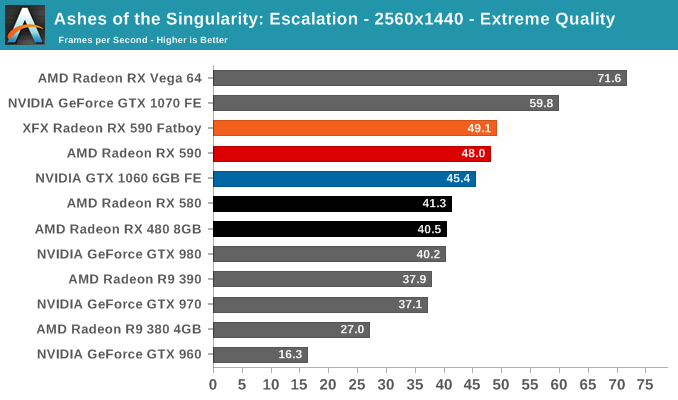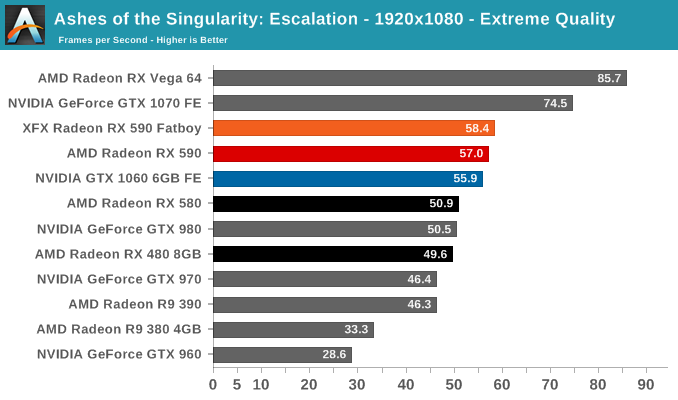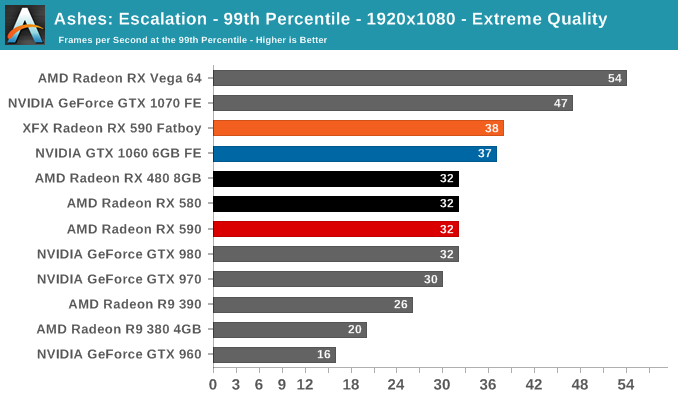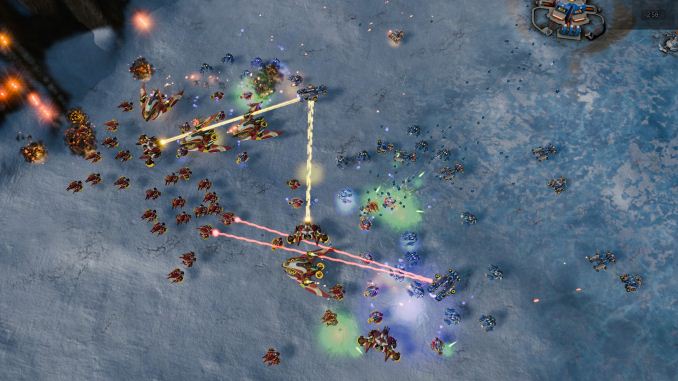The AMD Radeon RX 590 Review, feat. XFX & PowerColor: Polaris Returns (Again)
by Nate Oh on November 15, 2018 9:00 AM ESTAshes of the Singularity: Escalation (DX12)
A veteran from both our 2016 and 2017 game lists, Ashes of the Singularity: Escalation remains the DirectX 12 trailblazer, with developer Oxide Games tailoring and designing the Nitrous Engine around such low-level APIs. The game makes the most of DX12's key features, from asynchronous compute to multi-threaded work submission and high batch counts. And with full Vulkan support, Ashes provides a good common ground between the forward-looking APIs of today. Its built-in benchmark tool is still one of the most versatile ways of measuring in-game workloads in terms of output data, automation, and analysis; by offering such a tool publicly and as part-and-parcel of the game, it's an example that other developers should take note of.
Settings and methodology remain identical from its usage in the 2016 GPU suite. To note, we are utilizing the original Ashes Extreme graphical preset, which compares to the current one with MSAA dialed down from x4 to x2, as well as adjusting Texture Rank (MipsToRemove in settings.ini).


With Ashes, the RX 590 performance uplift over the RX 580 pays off in terms of beating its main competition, the GTX 1060 6GB. The lead is slim enough, however, that custom GTX 1060 6GB cards could easily make up the difference. With the price premium the RX 590 has over the GTX 1060 6GB, the reference GeForce is a little too close for comfort.


While not particularly known as a VRAM-eater, Ashes at 1440p brings down the GTX 960 and its anemic 2GB framebuffer, though it wouldn't be managing playable framerates anyhow.











136 Comments
View All Comments
neblogai - Thursday, November 15, 2018 - link
For me, and many other people 2080 or 2080Ti might as well not exist. I'd never buy any GPU priced like that. In fact, I'd never even buy a €300+ card. Also- power use is not an issue- at 200W+, it is easy to cool, not noisy, and savings in electricity cost from having a GTX1060 would be only €5-10 per year (at 20 hour gaming per week, which I do not achieve). And in a sub-€300 market- nVidia has not offered anything for 2.5 years. So it is certainly better deal to buy a faster RX590 and get a €180 AAA game bundle for free, compared to similarly priced, slower GTX1060. There are other reasons as well, like Freesync, and futureproofing like 8GB of VRAM and better driver support (because nVidia will be moving toward doing optimizations for 20xx series).eva02langley - Thursday, November 15, 2018 - link
It is a polaris card. Everybody knew what to expect. I am not sure what you are talking about.Navi is due next year and the contender will be the 2070 RTX. I am going to speculate a tag price of 300$ which is a whole 200-300$ less than a RTX.
mapesdhs - Thursday, November 15, 2018 - link
Xex360, AMD is not trying to compete because just don't buy them, so what's the point? There market and brand awareness simply isn't there to support a high end product stack atm, not until gamers stop being so irrational and actually buy AMD when they are objectively the more sensible option, whether based on price, performance or some combination of metrics.Cooe - Thursday, November 15, 2018 - link
"but now built on GlobalFoundries' 12nm process"Sorry, Nate, but ya got that one wrong. Polaris 30 is being fabbed at TSMC, just like the rest of AMD's GPUs.
eva02langley - Thursday, November 15, 2018 - link
... sure....porcupineLTD - Thursday, November 15, 2018 - link
Where are people getting this from?Ryan Smith - Thursday, November 15, 2018 - link
Note that we currently have no information cooroborating the use of TSMC. And indeed it seems incredibly unlikely given AMD's WSA, and the fact that Polaris 30 has the exact same die size as Polaris 10. TSMC and GF's 12nm processes are not identical, porting a chip to TSMC would given you different geometry dimensions.lmcd - Friday, November 16, 2018 - link
Just like the rest of AMD's...https://www.anandtech.com/show/10446/the-amd-radeo...
GPUs. Right.
maroon1 - Thursday, November 15, 2018 - link
What a jokeOnly 12% faster but also cost and consume more power than RX580 (and 108watt more than GTX 1060 at load)
It adds noting new. It just fills the big gap between RX580 and vega56
dr.denton - Saturday, November 17, 2018 - link
"It adds noting new. It just fills the big gap between RX580 and vega56"Literally all it was ever intended to do. Polaris is a 2 year old mid range GPU design, how do you expect anything revolutionary from that?